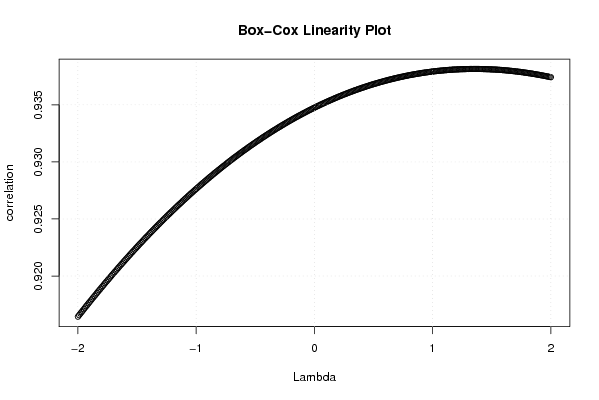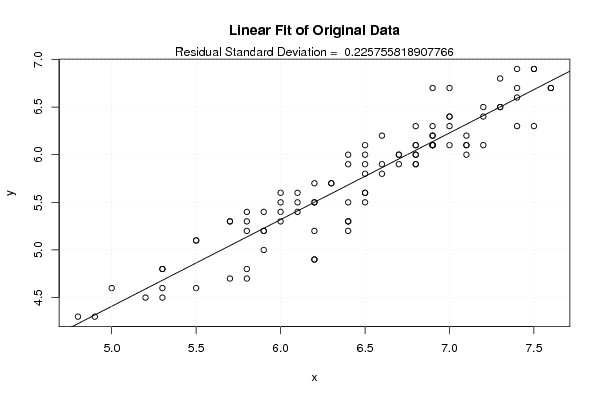Free Statistics
of Irreproducible Research!
Description of Statistical Computation | ||||||||||||||||||||||||||||||||||||||||||||||
|---|---|---|---|---|---|---|---|---|---|---|---|---|---|---|---|---|---|---|---|---|---|---|---|---|---|---|---|---|---|---|---|---|---|---|---|---|---|---|---|---|---|---|---|---|---|---|
| Author's title | ||||||||||||||||||||||||||||||||||||||||||||||
| Author | *The author of this computation has been verified* | |||||||||||||||||||||||||||||||||||||||||||||
| R Software Module | rwasp_boxcoxlin.wasp | |||||||||||||||||||||||||||||||||||||||||||||
| Title produced by software | Box-Cox Linearity Plot | |||||||||||||||||||||||||||||||||||||||||||||
| Date of computation | Wed, 12 Nov 2008 03:57:40 -0700 | |||||||||||||||||||||||||||||||||||||||||||||
| Cite this page as follows | Statistical Computations at FreeStatistics.org, Office for Research Development and Education, URL https://freestatistics.org/blog/index.php?v=date/2008/Nov/12/t1226487669f7n0n48vt1z79ij.htm/, Retrieved Sun, 19 May 2024 10:42:59 +0000 | |||||||||||||||||||||||||||||||||||||||||||||
| Statistical Computations at FreeStatistics.org, Office for Research Development and Education, URL https://freestatistics.org/blog/index.php?pk=24117, Retrieved Sun, 19 May 2024 10:42:59 +0000 | ||||||||||||||||||||||||||||||||||||||||||||||
| QR Codes: | ||||||||||||||||||||||||||||||||||||||||||||||
|
| ||||||||||||||||||||||||||||||||||||||||||||||
| Original text written by user: | ||||||||||||||||||||||||||||||||||||||||||||||
| IsPrivate? | No (this computation is public) | |||||||||||||||||||||||||||||||||||||||||||||
| User-defined keywords | Laura_Reussens K_Vanderheggen hundrasmet | |||||||||||||||||||||||||||||||||||||||||||||
| Estimated Impact | 173 | |||||||||||||||||||||||||||||||||||||||||||||
Tree of Dependent Computations | ||||||||||||||||||||||||||||||||||||||||||||||
| Family? (F = Feedback message, R = changed R code, M = changed R Module, P = changed Parameters, D = changed Data) | ||||||||||||||||||||||||||||||||||||||||||||||
| F [Box-Cox Linearity Plot] [Box Cox linearity...] [2008-11-12 10:57:40] [c9806d8558b4490616784faa930c3842] [Current] - D [Box-Cox Linearity Plot] [Paper Box-Cox] [2008-12-19 16:57:57] [1640119c345fbfa2091dc1243f79f7a6] | ||||||||||||||||||||||||||||||||||||||||||||||
| Feedback Forum | ||||||||||||||||||||||||||||||||||||||||||||||
Post a new message | ||||||||||||||||||||||||||||||||||||||||||||||
Dataset | ||||||||||||||||||||||||||||||||||||||||||||||
| Dataseries X: | ||||||||||||||||||||||||||||||||||||||||||||||
5,8 5,8 5,7 5,5 5,3 5,2 5,3 5,3 5,0 4,8 4,9 5,3 6,0 6,2 6,4 6,4 6,4 6,2 6,1 6,0 5,9 6,2 6,2 6,4 6,8 6,9 7,0 7,0 6,9 6,7 6,6 6,5 6,4 6,5 6,5 6,6 6,7 6,8 7,2 7,6 7,6 7,3 6,4 6,1 6,3 7,1 7,5 7,4 7,1 6,8 6,9 7,2 7,4 7,3 6,9 6,9 6,8 7,1 7,2 7,1 7,0 6,9 7,0 7,4 7,5 7,5 7,4 7,3 7,0 6,7 6,5 6,5 6,5 6,6 6,8 6,9 6,9 6,8 6,8 6,5 6,1 6,0 5,9 5,8 5,9 5,9 6,2 6,3 6,2 6,0 5,8 5,5 5,5 5,7 5,8 5,7 | ||||||||||||||||||||||||||||||||||||||||||||||
| Dataseries Y: | ||||||||||||||||||||||||||||||||||||||||||||||
4,7 4,8 4,7 4,6 4,5 4,5 4,8 4,8 4,6 4,3 4,3 4,6 5,4 5,5 5,5 5,3 5,2 5,2 5,4 5,3 5,0 4,9 4,9 5,3 6,3 6,7 6,7 6,4 6,1 6,0 6,2 6,1 6,0 6,0 5,9 5,9 6,0 6,1 6,4 6,7 6,7 6,5 5,9 5,6 5,7 6,0 6,3 6,3 6,2 6,1 6,3 6,5 6,6 6,5 6,2 6,2 5,9 6,1 6,1 6,1 6,1 6,1 6,3 6,7 6,9 6,9 6,9 6,8 6,4 5,9 5,5 5,6 5,6 5,8 5,9 6,1 6,1 6,0 6,0 5,8 5,5 5,5 5,4 5,2 5,2 5,2 5,5 5,7 5,7 5,6 5,4 5,1 5,1 5,3 5,3 5,3 | ||||||||||||||||||||||||||||||||||||||||||||||
Tables (Output of Computation) | ||||||||||||||||||||||||||||||||||||||||||||||
| ||||||||||||||||||||||||||||||||||||||||||||||
Figures (Output of Computation) | ||||||||||||||||||||||||||||||||||||||||||||||
Input Parameters & R Code | ||||||||||||||||||||||||||||||||||||||||||||||
| Parameters (Session): | ||||||||||||||||||||||||||||||||||||||||||||||
| Parameters (R input): | ||||||||||||||||||||||||||||||||||||||||||||||
| R code (references can be found in the software module): | ||||||||||||||||||||||||||||||||||||||||||||||
n <- length(x) | ||||||||||||||||||||||||||||||||||||||||||||||

















